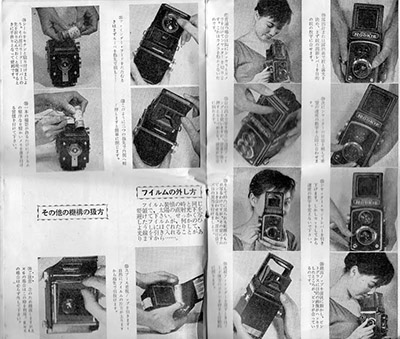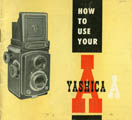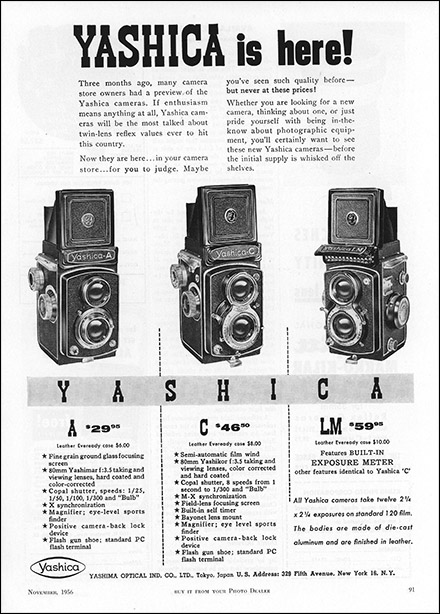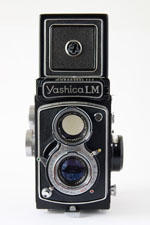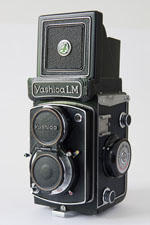66 Models
1956 to 1957
Yashica Rookie to Yashicaflex A2
The 66 Models are in chronological release date order split over seven pages to assist with the speed of displaying images.
The background to 66 Models and the various notes are at the beginning of the first page, 1953-1954.
Models
(Scrolling will take you down to the bottom of the page that you are on, clicking on links will take you to that model regardless of the page that you are on.)
1953-1954 The Simple Beginning |
||
| Pigeonflex | Yashima Flex | |
| Yashica Flex B | ||
1954 A Step Up - Japanese Icon |
||
| Yashica Flex S | ||
1954-1955 Full Range of Models Released |
||
| Yashicaflex A-I | Yashicaflex A-II | |
| Yashicaflex AS-I | Yashicaflex AS-II | |
| MolfoReflex | Yashicaflex C | |
| Yashicaflex A-III | ||
1956-1957 The “Yashica” is born |
||
| Yashica Rookie | Yashica Hi-Mec | |
| Yashica A | Yashica C | |
| Yashica LM | Yashicaflex A2 | |
1957 First Crank Wind and Last “Yashicaflex” models |
||
| Yashica-Mat | Yashicaflex AS (new model) | |
| Yashicaflex B (new model) | Yashicaflex A (new model) | |
1958-1959 The Classics, the 635 and D, Released |
||
| Yashica 635 | Yashica B | |
| Yashica D | Yashica A III | |
| Yashica Auto | ||
1960-1986 Crank Wind Sophistication plus Automation |
||
| Yashica Mat-LM | Yashica E | |
| Yashica Mat-EM | Yashica 24, 12 & Mat-124 | |
| Yashica Mat-124G | Yashica Mat-124B | |
Yashica Rookie
Basic budget model with 6x4.5 option
Probable release date |
Mar 1956 |
Probable end date |
Apr 1957 |
Lens |
Filter Mounts |
Frame Counter |
Shutter |
|||
Make/Type |
Sync |
S/Timer |
Speeds |
|||
Yashimar |
32 mm |
Red Window |
Copal |
X |
No |
B,1/25-1/300 |
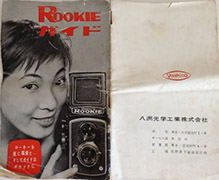
(Japanese user manual front and back cover image courtesy of Sandu Baciu, see pages below)
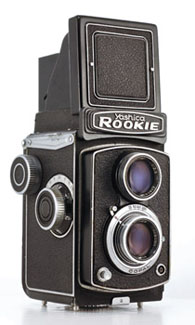 (Image courtesy of Tom Heckhaus)
(Image courtesy of Tom Heckhaus)
Although released first, basically, an early Yashica A without the hood emblem and film speed reminder on the film winding knob and the red window on the back turned sideways. The reason for the sideways window is that it is the only Yashica 6x6 that can shoot 6x4.5. The sideways window is in fact two windows side by side; the left engraved “6x6” and the right “6x4.5”. This takes advantage of the two sets of numbers on 120 film and allows 15 frames of 6 cm x 4.5 cm instead of the standard 6 cm x 6cm.
 (Image courtesy of Tom Heckhaus)
(Image courtesy of Tom Heckhaus)
Both the Rookie and Yashica A are close relatives of the late version of the Yashicaflex A-I, the major difference being the upgrade of the Copal shutter from the 1/10 to 1/200 speeds on the A-I to the 1/25 to 1/300 speeds on the Rookie and Yashica A.
All photos of production Rookies I have seen show a focusing hood with two pins similar to the Yashica 635 which has an accessory 35mm sports finder insert. One would expect the Rookie to have a similar insert for 6x4.5 use but the Japanese language user manual shows neither insert nor hood pins so I assume that the pins were a last minute addition. I have seen two cameras with hood masks, so presumably it is an original item but most seem to have been lost:
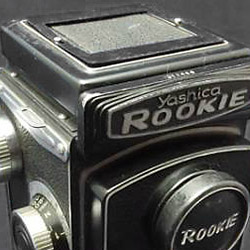 (Detail from larger web image)
(Detail from larger web image)
The user manual does show an internal mask being fitted in front of the focal plane:
(Document image courtesy of Sandu Baciu)
(Click on manual for larger view)
Image below is of a Rookie fitted with the internal mask, these items have rarely remained with their cameras:
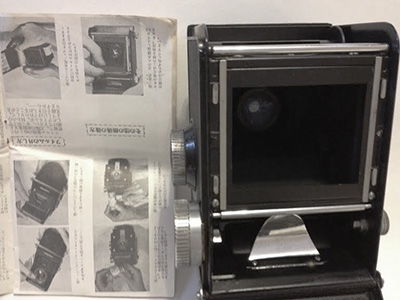
(Image courtesy of Sandu Baciu)
As with the Yashica A, the Rookie strap holders are of the Yashica Hi-Mec/LM type.
Elsewhere I have said that I believed that this was produced for the domestic Japanese market because of the distance scale in metres on the focusing knob (the early Yashica As were in feet). Very rare overseas but not so on Japanese auction sites. I also think that it is more likely than not that the Rookie and Yashica Hi-Mec were the pre-production fore-runners of the export focused Yashica A and LM but the Rookie concept was retained for the domestic market. The box below belongs to the second last Rookie in my database. As well as being of different construction than all its contemporaries including the Yashica A, note that it says “Yashicaflex” on the side. Although hard to see in the photo, under the Rookie name is “For Jr.”, presumably meaning “For Junior”. Together with the ability to economise by getting another three shots on the same film, you can see where the marketing idea was going. Except that most Japanese would not understand what “For Jr.” meant. This may have been a legacy of the abandoned export concept.
.jpg) (Image courtesy of Sandu Baciu)
(Image courtesy of Sandu Baciu)
Below is a Japanese guarantee certificate. Note that the model is simply listed as “Yashicaflex Model R” (the certificate is similar to earlier Japanese market Yashicaflex model A-II and C documents except the name of the document and company are in both English and Japanese on those). The fact that it identifies the camera as “Model R” rather than “Rookie” maybe an indicator that the word “rookie” also had no meaning for the vast majority of Japanese consumers.
 (Document image courtesy of Chris Whelan)
(Document image courtesy of Chris Whelan)
All the cameras in the database still have two silver squares on the focusing hood and the continuous parallel bars on the rear, trim features which were superceded on other models in production with the arrival of the Yashica-Mat in April 1957. Therefore, this model is unlikely to have lasted beyond then and may have been replaced by the Yashicaflex A (new model) advertised in Japan as the Yashica A.
There are 72 cameras in my database with serial numbers ranging from 197xxx to 233xxx. The later type spool knobs with narrow rim were introduced between camera 218xxx and 221xxx, although there are a couple of later examples still with the earlier knobs. Three screw accessory shoes were replaced by the four screw type from camera 222xxx onward.
Yashica Hi-Mec
Forerunner to Yashica LM
Probable release date |
early 1956 |
Probable end date |
early 1956 |
Lens |
Filter Mounts |
Frame Counter |
Shutter |
|||
Make/Type |
Sync |
S/Timer |
Speeds |
|||
Heliotar |
Bay 1 |
Counter |
Citizen MXV |
M/X |
Yes |
B,1-1/400 |
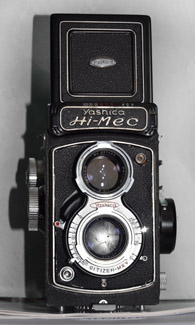
(Image courtesy of Jean-Marie Bussiere)
I had not heard of this model until correspondent Jean-Marie Bussiere wrote to me about his camera. Anyone reading the Yashica LM entry before August 2012 would have been aware of a camera with Citizen MXV shutter and Heliotar lenses that I thought was an early Yashica LM. Also, the “Yashica” inside the oval between the 2 lenses (but not the aperture scale) was red like all except the very last Yashicaflex C examples. Other Yashica LMs all have a black oval/name. It was the only one in the database with the earlier 8 flag ASA reminder on the film winding knob and the only one with metre focusing scale but without the 10 flag DIN film speed reminder. This is the camera:
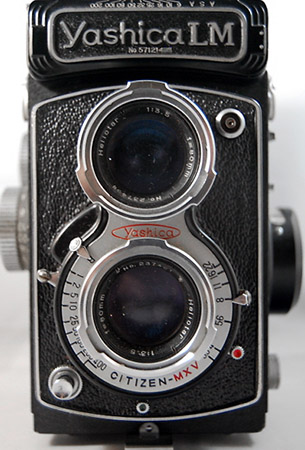
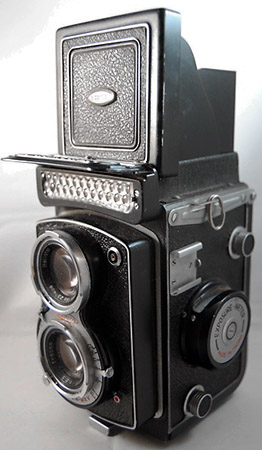
(Detail from larger web images)
The flap over the exposure meter cell is obviously not original. It displays the serial number like later cameras and is the fourth highest Yashica LM serial number in my database. It is now almost certain that its original flap would have been the same as the top camera (also featured below) which it matches in all other respects. I was also concerned that the focusing hood may have been from a Yashicaflex C but I can now see that the oval ring and text are in black rather than the red of the Yashicaflex C. The lens serial numbers of both cameras are very close.
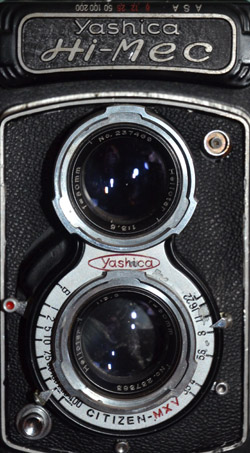
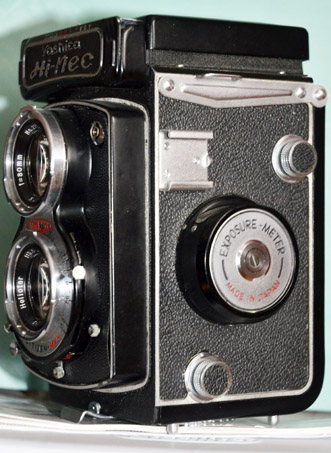

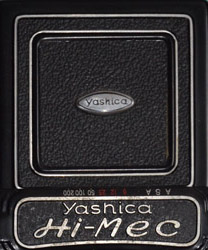
(Images courtesy of Jean-Marie Bussiere)
The photographs demonstrate both the similarities of the Hi-Mec to the LM (further below) and key differences noted above. One other difference is in the ASA scales on the top edge of the meter flaps; the slower speeds are shown in red on the Yashica Hi-Mec whereas they are all in white on the LM flap but with more intermediate numbers.
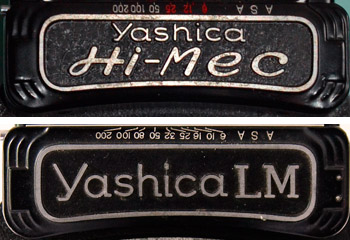
(Top image courtesy of Jean-Marie Bussiere)
In most key ways, the Hi-Mec is the same as the Yashica LM. Yet in other ways it is more primitive, or earlier. Although Yashica introduced a number of models with the Citizen shutter, there never seemed a continuing commitment to them. Heliotar lenses were the predecessor to Yashikor (Yashimar was used for budget models only). I'm fairly certain that it is the original version of the Yashica LM rather than some attempt to plug another marketing gap. If it was simply a rename of a model for marketing purposes, you would expect similar features, not early in one and late in the other. Jean-Marie's camera was sold with a Yashica LM box - there is no way of knowing whether this is original to the camera or not but it may represent a transitional period.
Although many collectors do not agree with me, “Rookie” was not a great marketing name either (in 1956) - who wants to be branded “Beginner” or “Learner”, implying not fully competent? Perhaps “Hi-Mec” was coined at a similar time or in similar circumstances? And then Yashica realised that there were better names, even boring ones like “A” and “LM”? With its focusing scale in metres, there is the possibility that it is a domestic Japanese version of the Yashica LM released a little earlier than the export versions, somewhat like the Yashica Rookie/ Yashica A, Yashicaflex A (new model)/ Yashica B and Yashicaflex B (new model)/ Yashica D. However, as it is not mentioned by Sugiyama, it is likely to be extremely rare in Japan as well. In that context and given the serial number below, it is possible that these two cameras were part of a pre-production series before release as the LM. However, how did they end up in general circulation?
Here is one theory based on both fact and speculation. A November 1956 ad in a US magazine featuring the Yashica A, C and LM models (see Yashica A below) starts with:
“YASHICA is here!
Three months ago, many camera store owners had a preview of the Yashica cameras.”
If the preview examples were pre-production models, could the preview example of the LM have been the Hi-Mec? A lot of dealers, a lot of preview samples? Some not making it back to Yashica?
One more mystery remains. “Yashica” models are clearly identified by the model name on the nameplate, in this case “Hi-Mec”. “Yashicaflex” models have no identification of model name except for the early Yashicaflex C which has “Model C” near the feed spool inside the base of the camera. Jean-Marie's camera has this in the same place:
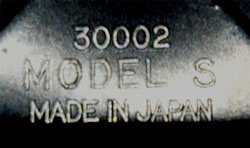
(Image courtesy of Jean-Marie Bussiere)
The number is presumably the serial number (quite interesting - where did the numbering start and adds weight to the idea of a pre-production example). Of course the bigger mystery is what does “Model S” mean? The Yashicaflex Model S (to give it its full name) was called “S” because of its Sekonic exposure meter. Does this “S” mean the same thing and why need an extra model identifier? Any possibility is simply a guess at this stage. One guess is that perhaps the Yashica C was originally going to be called “Hi-Mec” as well and the metered version would be the “Yashica Hi-Mec Model S”. The “Yashica” model name was only just being introduced, who knows what options the marketing people contemplated?
The two cameras are in my database. Camera 30002 may come first with taking lens 2373xx. The other has taking lens 2374xx. Both have viewing lens numbers in the same range, 2374xx.
Yashica A
Basic budget model
Probable release date |
Nov 1956 |
Probable end date |
Apr 1969 |
Lens |
Filter Mounts |
Frame Counter |
Shutter |
|||
Make/Type |
Sync |
S/Timer |
Speeds |
|||
Yashimar |
32 mm |
Red Window |
Copal |
X |
No |
B,1/25-1/300 |
Yashikor |
32 mm |
Red Window |
Copal |
X |
No |
B,1/25-1/300 |
| Yashikor replaced Yashimar between Jan & Apr 1959 | ||||||
(Click on covers for PDF of full first version manual provided courtesy of Chris Whelan or for second or third version manuals provided courtesy of Tom Heckhaus. Interestingly, the flight attendant on the first cover, also appearing inside the second one, is in the uniform of Canadian Pacific Airlines)
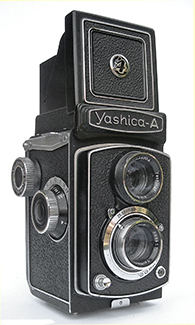
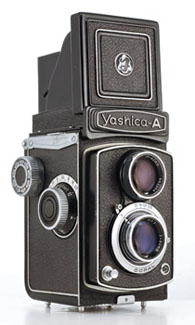
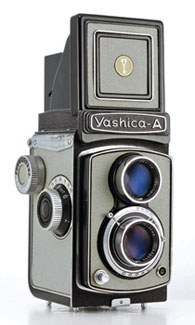
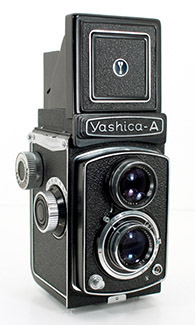
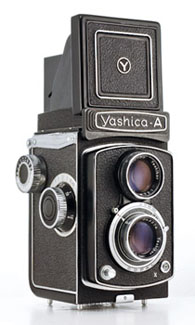
(Image 1 courtesy of Leigh Harris, images 2, 3 & 5 courtesy of Tom Heckhaus, image 4 courtesy of Jason Hull, see Flickr for original)
Like the first camera above, the first 1956 cameras still had the early spool knobs and focusing hoods with two silver squares and all black logo:
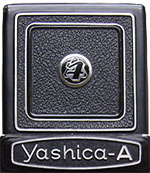 (Detail from larger web image)
(Detail from larger web image)
The second camera is probably from early 1957 and has the new focusing hood and logo. Note that until coloured examples arrived in early 1959, Yashica A nameplates have a more pronounced curve to the silver outline than the later cameras and the tail on the “Y” is longer (see the hood/nameplate images above and below). The grey camera falls into the 1959 to 1960 period of coloured Yashica A models, the fourth camera is from the 1960 to 1965 period and the fifth camera is the fourth last in the database and from 1968. It is typical of examples from 1965 onward. There is a coloured domestic Japanese variant named Yashica A III (covered as a separate model). It is without hood logo and was released in 1959:
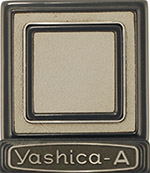 (Image courtesy of Tom Heckhaus)
(Image courtesy of Tom Heckhaus)
Many references suggest a 1958 introduction date. McKeown suggests 1959 (earlier editions at least), probably based on Sugiyama's “Yashica-AIII”. However, the Yashica A is one of the first group of three “Yashica” named export models released simultaneously in 1956, possibly as early as September 1956 according to the book “Yashica Guide” by Richard Lowell but first advertised, as far as I have been able to ascertain, in November 1956 which is the date that I have now conservatively adopted. Below are ads with November and December 1956 dates (importantly, the ads also sets the date for the Yashica C and Yashica LM). The first ad also appeared in U.S. Camera, again claimed to be in the November 1956 edition (no date is evident on the removed single page displayed for sale).
(Click on ad for larger PDF also showing reverse with publication name)

(Detail from larger web image)
The December ad also appears on page 47 of the January 1957 edition of U.S. Camera. Further confirmation is provided by a Japanese brochure published in December 1956 which refers to a US review of the Yashica C and LM.
There are numerous ads from April 1957 onward featuring the new Yashica-Mat whilst also referring to the Yashica A, C and LM. The Yashica A seems to have lasted in production until the latter half of 1968, although April 1969 is claimed. There are eleven 1968 cameras in my database with the last with a September serial number but no cameras from 1969. The full period is absolutely consistent with trim details and changes found on particular examples compared to other models.
The Yashica A is a basic camera (but with the later Yashikor lenses, capable of the same quality images as the Yashica D or 635), in reality hardly different to a late Yashima Flex with NKS-FB shutter except with Yashimar lenses initially (reserved for budget models and therefore probably of lower quality) in an updated Copal shutter but befitting its budget status, without the self-timer or slow speeds below 1/10 sec. It is even physically closer to the Yashicaflex A-I, its spiritual and marketing predecessor. It has a basic locking lever shared with the Rookie and late Yashicaflex A-I and A-II models. Price was the only reason for its existence: half the Yashica LM price and around two thirds the price of a Yashica C. It was the entry level for at least a dozen years. Presumably because of economy or the perception of economy, it like the Rookie, was fitted with the simpler 2 screw strap holders/ hinge plates most likely designed for the Yashica LM with its cramped meter readout and accessory shoe location (the LM was a relatively expensive camera, it cost some US$10 more than the Yashica D when they were both on the market at the same time).
Although the later Yashica A III variant was available in at least three colour combinations, I have only found coloured Yashica As with black metalwork and grey leatherette. Anything other than black leatherette is restricted to the 1959 to 1960 period.
Six of the first ten cameras, from 303xx to 359xx, including the first two, have 3 screws in the accessory shoe. Two have 4 screws and two are not visible. All later examples have 4 screws. The first ten cameras, up to 38xxx, are the only ones with the old style spool knobs. Up to the same camera, they don't have “Made in Japan” on the locking knob, after which they do. The early cameras have 9 flag ASA film speed reminders except for four which have a 10 flag DIN reminder and metre focus scale. Camera 594xx has the new black-white-black type hood logo. It is unusual because with other models, the new hood style usually appears well before the new logo. The next camera, 601xx also has the logo but the rest of the hood details are unknown. This is followed by 615xx with the new hood logo and is the first confirmed example with the new hood with the long silver parallel bars on the rear of the focusing hood split into two pair, the two silver squares on the hood reduced to one and the reinforcing on the rear hood blind reduced from three panels to two.
The last camera in this series is 670xx with taking lens 854xxx. There are five cameras with 6 digit numbers 790xxx to 793xxx with lenses 873xxx to 900xxx. These are the first with date coding, “7” representing 1957 and “9” representing September. With October, the year changed to “57” but that didn't happen right at the beginning. Correspondent Terry Dean's early October Yashica A, 7100332 with taking lens 897305, still uses the earlier system of “7” for the year and now “10” for the month:
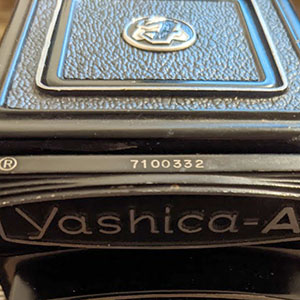 (Image courtesy of Terry Dean)
(Image courtesy of Terry Dean)
Then there are eleven cameras with 8 digit numbers 57101xxx (lens 960xxx) to 57121 which is the last of the 9 flag film winding knob models. The next nine numbers are 7 digits, 5840xxx to 5883xxx, with seemingly two separate lens series starting from 215xxx and 410xxx. The first, 5840xxx, is the last with 9 flag ASA speed reminder and the next, 5840xxx (some 190 cameras later) is the last with 10 flag DIN film type. All following examples have the new film winding knob with half silver half black DIN/ASA scale. Then there are another four with 8 digit numbers, 38100xxx to 38121xxx (taking lenses 425xxxx to 462xxx).
A new series of 7 digit numbers begins with 3911xxx. Camera 3940xxx is the first coloured example, black with grey leatherette and the first with Yashikor, instead of Yashimar, lenses. Its hood logo is missing but the next camera, also 3940xxx, has the new hood logo with the narrow “Y” on gold background. This example is followed by a block of 28 cameras with 7 digit numbers up to 3991xxx (1959 September). This block also had “Made in Japan” and then shortly after, still in the 3940xxx range, simply “Japan” inside the accessory shoe. These cameras also don't have “Made in Japan” on the locking knob. Four random cameras in the series have plain shoes - unless replaced, any explanation is a guess.
There are two cameras with 8 digit numbers, 39101xxx and 39102xxx (both 1959 October) followed by 7 digit 4121xxx (1959 December, the “4” from Showa 34 replacing the “39” made up of the combined “3” and “9” from Showa 34 and 1959 respectively) .
A new block starts with the numbers reverting to six digits. There is a single camera with serial number 611xxx (lens 570xxx). It is the first example with the narrow “Y” hood logo with blue background. It is also the last example with “Japan” inside the accessory shoe and the first with “Made in Japan” reappearing on the locking knob - a cross over camera with both. The focusing knob is not visible so either this camera, or the next, 630xxx (lens 582xxx), is the first with a dual metres/feet focus scale. Then there are three with 640xxx numbers. Camera 641xxx (lens 595xxx), is the last coloured camera. Camera 650xxx (lens 623xxx), is the last of the 6 digit numbers and the first that is all black again.
The block of coloured cameras in my database is contiguous, i.e., after the first one, there are no black cameras until the coloured cameras cease.
Correspondent Joanna Floyd has provided details and photos of her black camera which by features and lens number, 653xxx, belongs here. It has an unusual 9 digit serial number, 116110451 which translates as follows: “11” = Yashica A, “6” = 1960, “11” = November and “0451” = the usual 4 digit sequence number for the month. Similar numbers also appeared briefly on other models right at the end of 1960. Details are on the Serial Numbers page.


(Images courtesy of Joanna Floyd)
The last block of numbers runs from A 1030xxx (lens number of next camera is 694xxx) to the last Yashica A in my database, A 8090799 with taking lens 866942 and viewing lens 863770, owned by correspondent Jon Allyn:
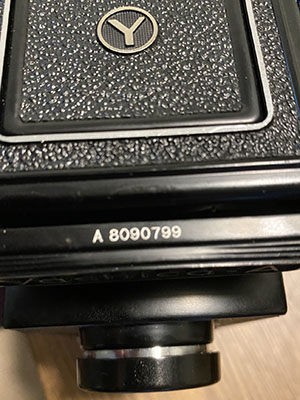
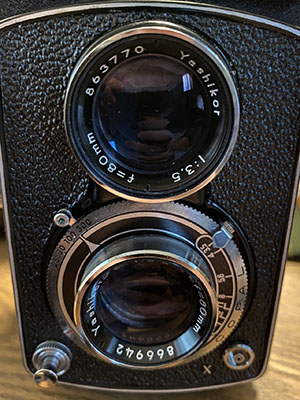 (Images courtesy of Jon Allyn)
(Images courtesy of Jon Allyn)
These body serial numbers represent the period from March 1961 to September 1968 – see “Serial Numbers”. All are black. At camera A 6040xxx, the hood emblem changed to the wide “Y” and according to my database, the parallel bars on the back edge of the hood changed to black from camera A 7041xxx onward, i.e., from April 1967. All other models still in production seemed to change between July and September 1967. There is one slightly earlier camera with the black bars, A 6121xxx, but for one reason or another, this seems like an outlier. The last 1968 cameras have a textured finish to the focusing hood blind.
Approximately 2/3rds of all Yashica A cameras in my database are from 1960 or earlier and there are relatively few from later years reflecting the evolving photographic market of the time and the demise of the entry level TLR. Also, before dual scale focusing knobs, 60 of 71 cameras with scales visible have focusing scales in feet. Four of the 11 examples with metre scales have the 10 flag DIN film speed reminder suggesting European export. There is one on which the scale is not visible and the balance of the 6 have the later dual DIN/ASA scales and could also have been destined for Europe. My suggestion is that early production was not geared towards domestic Japanese consumption. That need was perhaps initially met by the Rookie, followed by the Yashicaflex A (new model) and then the Yashica A III variant.
Yashica C
Premium model, meterless
Probable release date |
Nov 1956 |
Probable end date |
Feb 1959 |
Lens |
Filter Mounts |
Frame Counter |
Shutter |
|||
Make/Type |
Sync |
S/Timer |
Speeds |
|||
Yashikor |
Bay 1 |
Counter |
Copal MX |
M/X |
Yes |
B,1-1/300 |
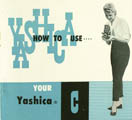
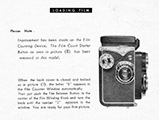 (Click on cover for PDF of full second version manual with reset button provided courtesy of Göran Årelind and on later Yashica C/LM supplementary page for larger view, provided courtesy of Chris Whelan. Note, first manual cover has the same Canadian Pacific Airlines flight attendant shown on Yashica A and LM covers and , third version has same cover as second, similar to both Yashica A & LM, and deletes reference to film counter reset switch which is now set automatically.)
(Click on cover for PDF of full second version manual with reset button provided courtesy of Göran Årelind and on later Yashica C/LM supplementary page for larger view, provided courtesy of Chris Whelan. Note, first manual cover has the same Canadian Pacific Airlines flight attendant shown on Yashica A and LM covers and , third version has same cover as second, similar to both Yashica A & LM, and deletes reference to film counter reset switch which is now set automatically.)
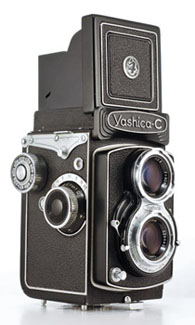
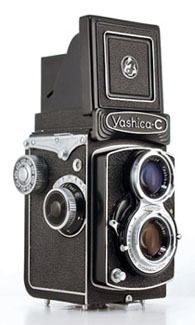
(Images courtesy of Tom Heckhaus)
These two represent the focusing hood style and logo change, loss of reset button (change from semi-automatic to fully automatic film counter) and locking lever change. On the unseen side is the change from early to late type spool knobs.
Like the A and LM, certainly released in late 1956, no later than November (see Yashica LM above). Except for the lack of meter, it is the same as the Yashica LM and changes mirror the LM. Production almost certainly ceased in early 1959 but both the C and LM were still being advertised in the Olden Camera & Lens Co catalogue of 1960. From another perspective, it was barely an update of the Yashicaflex C, adding only a fresnel focusing screen, M/X flash sync switching (utilising the Copal self-timer escapement to add the necessary delay for M sync) and changing the viewing lens from Tri-Lausar to Yashikor (possibly a name change only). Yashima even wanted buyers to see the connection. The Yashica Rookie and Yashica A introduced a new nameplate style also seen on later models and the last of the Yashicaflexes, however, the Yashica C mimics the unique style of its direct ancestor:



(Images courtesy of Tom Heckhaus)
Similar to the Yashica LM, all visible distance scales are in feet except for those examples with a 10 flag DIN film reminder and three of the five examples with combined DIN/ASA scales.
The appearance, or not, of “Made in Japan” on the locking knob is dealt with in “Tripod mounts/ Locking Knobs”. As with the very last few Yashica LMs in my database, the last few Cs have “Made in Japan” on the faceplate, just above the shutter name (see Yashica LM below).
The earliest two examples have taking lenses 267xxx and 295xxx. The first confirmed body number is 800xxx with new lens series number 453xxx (this lens number pattern is the same as the early LM). The early cameras have 3 screws in the accessory shoe, certainly by body number 802xxx (lens number 526xxx) they have 4 screws. Camera 805xxx is the first of five Yashica Cs with a 10 flag DIN film reminder (last is camera 791xxx) and metre focus distance scale whilst all the other Yashica Cs have feet scales (except for the last three with combined DIN/ASA scales). Between camera 807xxx and 809xxx is the first with the new hood with the long silver parallel bars on the rear of the focusing hood split into two pair, the two silver squares on the hood reduced to one and the reinforcing on the rear hood blind reduced from three panels to two.
Camera 817xxx is the last with the bent strap locking lever and film counter reset button. The next camera is 819xxx. It and all following cameras have the moulded locking lever and automatic counter reset. This block of numbers goes to 829xxx which is the first camera with the new black-white-black hood logo type.
A new 6 digit numbering system starting with “79” was introduced across all models in September 1957. There are four or five Yashica C examples with numbers from 791xxx to 793xxx. Then there are six 8 digit numbers from 57100xxx to 57122xxx followed by two 7 digit numbers in the 5880xxx range (also all consistent with contemporary models and similar to the last Yashica LM numbers). The second last number is eight digits again, 38101xxx; according to my theory on the Serial Numbers page, from October 1958. The last number is 3910xxx from January 1959. The last five cameras in the database are the first with the late type silver and black combined DIN/ASA film speed reminder scale. Three of these have the focus scale in metres and two in feet.
Yashica LM
Premium model with exposure meter
Probable release date |
Nov 1956 |
Probable end date |
mid 1958 |
Lens |
Filter Mounts |
Frame Counter |
Shutter |
|||
Make/Type |
Sync |
S/Timer |
Speeds |
|||
Yashikor |
Bay 1 |
Counter |
Copal MX |
M/X |
Yes |
B,1-1/300 |
.jpg)

 (Click on second cover for PDF of full manual with reset button and on later Yashica LM/C supplementary page for larger view, provided courtesy of Chris Whelan. Note, third version has same cover as second, deletes reference to film counter reset switch which is now set automatically. Cover of first version uses a similar Canadian Pacific Airlines flight attendant photo to the Yashica A and C and the second cover also uses the same model as the other two.)
(Click on second cover for PDF of full manual with reset button and on later Yashica LM/C supplementary page for larger view, provided courtesy of Chris Whelan. Note, third version has same cover as second, deletes reference to film counter reset switch which is now set automatically. Cover of first version uses a similar Canadian Pacific Airlines flight attendant photo to the Yashica A and C and the second cover also uses the same model as the other two.)
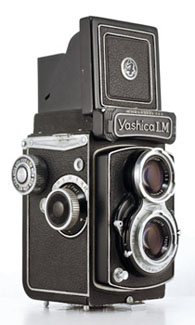
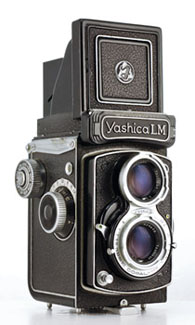
(Images courtesy of Tom Heckhaus)
These two represent the hood style change, logo change, loss of reset button (change from semi-automatic to fully automatic film counter) and locking lever change. On the unseen side is the change from low set accessory shoe to high set and early to late type spool knobs. However, the many improvements or variations occurred mainly one at a time over the life of this model.
Below are two other views of a similar camera to the one on the left, above:
(Click on camera to view larger image)
Designed to replace the Yashicaflex S with new light meter sensor, more compact readout housing, improved lenses (improved, or simply a name change is unknown), shutter with M/X switch and an accessory shoe, they coexisted for a brief period (the S was still definitely being made in 1957). Unlike with the Yashicaflex S, not much is known about the exposure meter with no external branding visible. The nameplate exposure flap is either up for use or closed - there is no dual range and like the Yashicaflex AS-II, the scale under the meter needle is an f/stop aperture scale and not the light value scale of the Yashicaflex S. Accordingly, the exposure calculator on top of the meter cell housing operates in a similar way to the AS-II. A little unusual is the meter reading scale on the side of the camera which ranges from f/45, f/32 ......f/1.4, f/1, f/0. Any benefit from knowing how many stops you are short of the camera's exposure capability would be far offset by the inconvenience of the cramped readout.
Although some sources claim a late 1957 release date, the ads in the Yashica A entry are unequivocal about it being available as early as November 1956 and there is some evidence that it was announced as early as September. There are numerous ads from 1957 featuring the new Yashica-Mat whilst also referring to the Yashica A, C and LM.
The book, “Collector's Pictoral Encyclopaedia & Value Guide to 6x6 TLR Cameras” by Karl F. Kahlau lists one example of the Yashica LM with Heliotar lenses still. However, unlike the Yashica Hi-Mec, that one has a Copal MX shutter already. I am not entirely convinced. He also lists an example with Yashinon lenses - I believe that information originated from a Swedish ad with a number of obvious errors. An early user manual only has “Yashikor” lenses visible but having said that, nothing with Yashica is ever simple. I have compared the Yashica C and LM user manuals and just like with the earlier Yashicaflex A and AS user manuals, photos have been shared/re-used. In fact, the same lens numbers reappear and on one page of the early LM manual, there is a picture of a camera with only the lower half of the nameplate showing but the name is very clearly “Yashica C”.
The appearance, or not, of “Made in Japan” on the locking knob is dealt with in “Tripod mounts/ Locking Knobs” but all examples, including the Hi-Mec, have it on the meter body regardless of whether it appears elsewhere. As with the very last few Yashica Cs in my database, the last few LMs have “Made in Japan” on the faceplate, just above the shutter name. This became standard for all knob wind models with faceplates except for the Hong Kong made Yashica D:
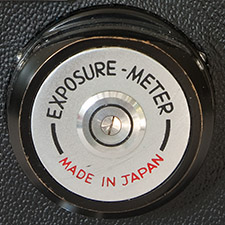
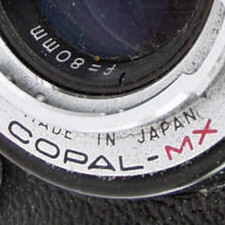 (Right detail from larger web image)
(Right detail from larger web image)
By both serial number and trim, it looks like production of the Yashica C and LM stopped in the second half of 1958. However, they are still listed in the Olden Camera and Lens Company, Inc. of New York catalogue of 1960 and both models appear in a 1959 Yashica ad. Perhaps there was old stock to clear?
The first Yashica LMs have the serial number inside the body near the feed spool and 9 flag film speed reminders already. The first two have lens serial numbers 268xxx and 282xxx and the first body serial number recorded is 100xxx with lens number 285xxx. This camera and the next with new lens series number 473xxx are the first with four screws in the accessory shoe instead of three (although the following two have 3 again before 4 is consistent). My 103139 has taking lens 492491 and viewing lens 516429. The previous camera is probably the first with the late spool knobs (lens numbers only).
Just after 106xxx, the accessory shoe moved from almost touching the light meter readout housing to close to the hinge plate:
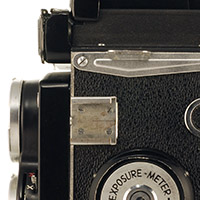
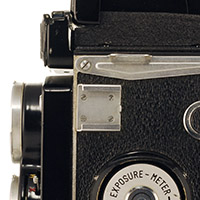 (Images courtesy of Tom Heckhaus)
(Images courtesy of Tom Heckhaus)
The same camera is the first of eight with 10 flag DIN film speed reminder (last is the last example, 5820xxx) on the film winding knob. At around 109xxx, the long silver parallel bars on the rear of the focusing hood were separated into two pair, the two silver squares on the hood reduced to one and the reinforcing on the rear hood blind reduced from three panels to two. Between body number 115xxx (lens 447xxx) and 118xxx (lens 815xxx) at taking lens number 781xxx, the locking lever changed to the moulded type (there is one example with earlier lens number 694xxx). On the next camera, the film counter reset button was replaced by fully automatic reset and the button disappeared for ever. At the same time, the hood logo changed to the black-white-black type. At 121xxx, the serial number moved to the front nameplate but 123xxx had the number inside again:
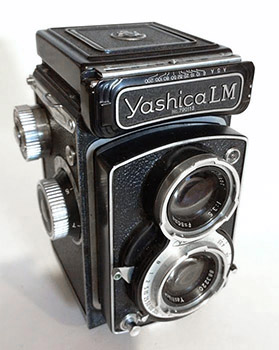 (Image courtesy of Sandu Baciu)
(Image courtesy of Sandu Baciu)
After 127xxx, the next block of numbers ran from 790xxx to 791xxx, then three 7 digit numbers in the 7100xxx to 7110xxxrange, ten cameras with 8 digit numbers, 57110xxx to 57120xxx. Finally, there are four 7 digit examples from 5810xxx to 5820xxx. Six of the last seven cameras have the late type silver and black combined DIN/ASA film speed reminder scales but the very last has the 10 flag DIN reminder scale.
All, except DIN scale cameras have focus scales in feet including three of the four with the new DIN/ASA film winding knobs. The Yashica C is similar. The conclusion I draw from this is that all of the production of the two models was destined for export. Elsewhere, I have linked this to the new “Yashica” name.
As far as I can tell, all the cameras were supplied with the hinged alloy lens caps.
One thing about the Yashica LM that sets it apart is its covering. All of the Yashima/ Yashica models are old cameras. A number of examples in my database have loose or damaged coverings through wear, repair, storage environment etc but by far the majority appear to be in very good condition. Not the Yashica LM (or some earlyish Yashica-Mats). At least 43 cameras of 109 in the database have a problem and the loss or damage is much greater than other models. On mine, in excellent condition in other respects, the camera simply denuded itself over time and the bits were too brittle to reattach. Earlier LMs, from camera 102xxx to 107xxx, are much more likely to be affected but not the very earliest . Surprisingly, its meterless sibling, the Yashica C does not appear to suffer to the same extent.
Yashicaflex A2
aka Yashicaflex A-2, Yashica A2 and Yashica A-2, budget model with high spec shutter
Probable release date |
Oct 1956 |
Probable end date |
Jun 1957 |
Lens |
Filter Mounts |
Frame Counter |
Shutter |
|||
Make/Type |
Sync |
S/Timer |
Speeds |
|||
Yashimar |
36 mm |
Red Window |
Citizen MXV |
M/X |
Yes |
B,1-1/400 |
Over 25% Are Found with Copal Shutters |
||||||
Yashimar |
36 mm |
Red Window |
Copal MXV |
M/X |
Yes |
B,1-1/500 |
Yashimar |
Bay 1 |
Red Window |
Copal MXV |
M/X |
Yes |
B,1-1/500 |
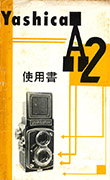
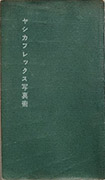 (Click on cover of Japanese instruction sheet for full PDF, courtesy of Leigh Harris. Instruction sheet believed to have been supplied together with 20 August 1956 edition of Yashicaflex Photography, cover shown on right - see Japanese Language User Manuals & Guides.)
(Click on cover of Japanese instruction sheet for full PDF, courtesy of Leigh Harris. Instruction sheet believed to have been supplied together with 20 August 1956 edition of Yashicaflex Photography, cover shown on right - see Japanese Language User Manuals & Guides.)
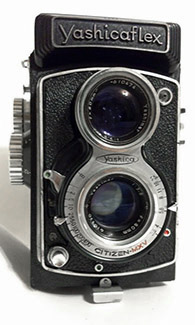

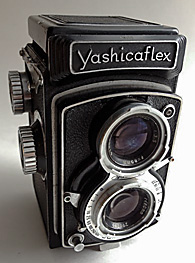
(Left and right images courtesy of Sandu Baciu, middle image courtesy of Adam Cheng)
Claimed production from October 1956 to June 1957 fits well with the camera's trim. It has the later spool knobs and four screws in the accessory shoe that arrived after the first Yashica A, C and LM examples and the hood style and its bent strap locking lever were gone by the time of the arrival of the Yashicaflex AS (new model) in May 1957. Japan only model which appears in both a 1956 and 1957 brochure.
This is an odd model. Except for the shutter, it has basic specs, including Yashimar lenses and red window film advance. Advertised and typically found with plain 36 mm filter mounts and Citizen MXV shutter with 1/400 top speed (camera 1), it is also sometimes found with Copal MXV shutter with a 1/500 top speed (camera 2) and a small sub-set of those are fitted with Bay 1 filter mounts (camera 3). The cameras fitted with Copal shutter, including those with the Bay 1 mounts, are dotted throughout the serial number range. Brochures and documentation only ever mention/picture the plain filter mounts and Citizen shutter.
Trim
The Yashicaflex A2 has unique film speed reminder graphics on the film winding knob which is shared with the later Yashicaflex A (new model), although that has a centre button instead of leatherette insert. The flags are white on a white background with the outline in the same red and black colour as the text:
.jpg) (Image courtesy of Adam Cheng)
(Image courtesy of Adam Cheng)
Japanese brochures show that the camera was fitted with the late Yashicaflex A-I/ A-II/ Yashica A/ Rookie type locking lever but all examples found in the wild have the bent strap type.
The Yashicaflex A2 is the second Yashima camera to have the shutter faceplate normally used with Bay 1 mounts (after the earlier Yashicaflex A-III) but it is the first with plain filter mounts of 36 mm diameter. Like some earlier A series models and also the Rookie, there is no hood emblem and the hoods are the earlier type with 2 silver squares and unbroken parallel bars on the back. Except for the film speed reminder, the film winding knob is the same as the late Yashicaflex A-I and early Yashica A with leatherette centre.
Name
Accepted convention is that this model is called the “Yashicaflex A2” but a Japanese brochure from the period calls it an “A-2”:

For a while, I even changed this website but several cameras have turned up with a guarantee certificate for the “Yashicaflex model A2” and below is an instruction sheet with “Yashica A2” on the cover:
 (Document scan courtesy of Leigh Harris)
(Document scan courtesy of Leigh Harris)
Like subsequent boxes for other Japanese domestic market models in the 1956 to 1958 period, Yashicaflex A2 boxes are marked with both “Yashicaflex A2” and “Yashica A2”. I also have a copy of yet another Japanese brochure for the “Yashica A-2” where the nameplate on the camera is “Yashicaflex”. The A2 is from the period that the “Yashica” name was being introduced for export models but there was still a transition arrangement for Japanese consumers (see here) to get them used to the new name - there is quite a bit of marketing material supporting that premise. Here is a montage of the detail from boxes and brochure:
 (Detail from larger web images)
(Detail from larger web images)
However, to return to the point in question, is it “A2” or “A-2”? Don't know. I doubt that Yashica was certain. So I have reverted to convention.
Copal Shutter
There are 20 cameras with Copal shutter and plain filter mounts and another 9 with Copal shutter and Bay 1 filter mounts amongst the 111 A2 examples in my database. The only other Yashica/Yashicaflex models with the Copal MXV shutter have control wheels.
The Citizen MXV shutter has a lever with a round knob and green dot at the bottom of the assembly - that is the M/X switch (see top left photo) whereas the Copal switch has its typical knob with yellow dot at between the 1 and 2 o'clock positions. Camera 18xxx with taking lens 616xxx, belonging to correspondent Adam Cheng:
.jpg) (Image courtesy of Adam Cheng)
(Image courtesy of Adam Cheng)
There are other instances of Yashima upgrading shutters during model runs. The shutters are usually of similar spec and always, the change is from <other brand> to Copal. It would be logical to believe that the twenty cameras with Copal shutter are at the end of the serial number range. In fact, they are spread throughout the range with a slight concentration towards the end:
Serial Number
|
Shutter |
Filter Mounts |
Number of Cameras |
|
From |
To |
|||
27xx |
61xx |
Citizen |
Plain |
12 |
62xx |
Copal |
Plain |
1 |
|
67xx |
69xx |
Citizen |
Plain |
4 |
71xx |
7xxx |
Copal |
Plain |
2 |
7xxx |
90xx |
Citizen |
Plain |
18 |
xxxx |
91xx |
Copal |
Bay 1 |
2 |
95xx |
Copal |
Plain |
1 |
|
98xx |
98xx |
Citizen |
Plain |
3 |
99xx |
Copal |
Bay 1 |
1 |
|
100xx |
Citizen |
Plain |
1 |
|
xxxxx |
101xx |
Copal |
Bay 1 |
2 |
101xx |
103xx |
Citizen |
Plain |
2 |
103xx |
Copal |
Plain |
1 |
|
115xx |
133xx |
Citizen |
Plain |
7 |
137xx |
Copal |
Plain |
1 |
|
137xx |
144xx |
Citizen |
Plain |
4 |
145xx |
Copal |
Plain |
1 |
|
145xx |
162xx |
Citizen |
Plain |
17 |
164xx |
1xxxx |
Copal |
Plain |
4 |
174xx |
174xx |
Citizen |
Plain |
2 |
1xxxx |
1xxxx |
Copal |
Plain |
2 |
176xx |
Citizen |
Plain |
1 |
|
178xx |
Copal |
Plain |
1 |
|
179xx |
Citizen |
Plain |
1 |
|
182xx |
18xxx |
Copal |
Plain |
2 |
183xx |
185xx |
Citizen |
Plain |
3 |
xxxxx |
Copal |
Plain |
1 |
|
187xx |
188xx |
Citizen |
Plain |
3 |
188xx |
Copal |
Plain |
1 |
|
190xx |
270xx |
Citizen |
Plain |
2 |
288xx |
288xx |
Copal |
Bay 1 |
3 |
381xx |
Citizen |
Plain |
1 |
|
1219xx |
Copal |
Bay 1 |
1 |
|
3300xx |
Citizen |
Plain |
1 |
|
3302xx |
3303xx |
Copal |
Plain |
2 |
I can only guess at why this would be. Given that the serial numbers belong to the same range, the cameras are almost certainly the same A2 model. Perhaps there was a supply issue? However, with other models, when there was a shutter change, there was a hard cut-off from one type to another. I have also noted that 5 out of 80 examples of the Yashicaflex AS (new model) in my database were fitted with a Copal MXV shutter instead of the normal Citizen MXV. In that case I suggested that it could be something to do with an inherent weakness in the Citizen shutter and Yashima/Yashica's repair policies, i.e., replacing defective Citizen shutters with the closest Copal equivalent. However, with that camera, there was an obvious easy donor model for the new faceplate required (still with the donor's trim) but none for the A2 so the Copal faceplate is unique and specially made by Yashima/Yashica.
Copal Shutter & Bay 1 Mounts
I have previously called this version “Yashicaflex unknown model”. However, I had been coming around to the idea that it didn't make sense for Yashima to create yet another minor variation of what is clearly a budget model and that something else was going on. Then one was offered for sale with both its inner and outer boxes, both clearly marked “Yashicaflex A2” (the “2” and the top of the “A” overlaying it are just visible on the lid of the outer box in the first photo):

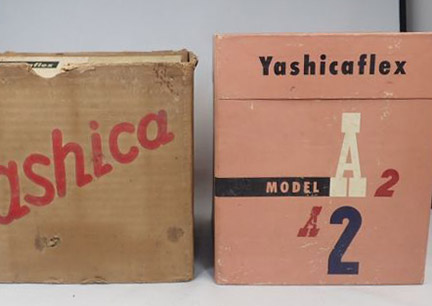

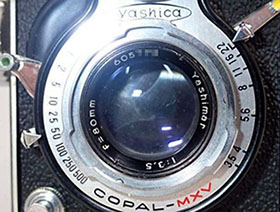
(Details from larger web images)
Note the folding metal lens cap in lieu of the “normal” hard plastic 36 mm slip-on type.
I have already suggested that perhaps Yashica replaced defective Citizen shutters with the nearest matching Copal model, the MXV and that this would have required a new front panel with included lens bezels. Perhaps Yashica offered owners the option of plain or Bay 1 mounts? That is pure speculation but nothing about this version makes sense and I am starting to think that was the reason.
Here are some more images of the camera featured at the top of the A2 entry:

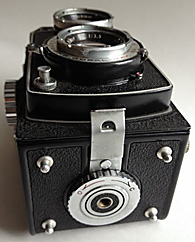
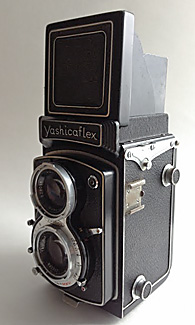
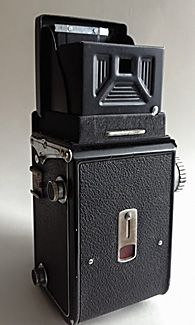 (Images courtesy of Sandu Baciu)
(Images courtesy of Sandu Baciu)
Below is the first example I saw. It was on a Japanese website with the caption of “unknown model”:
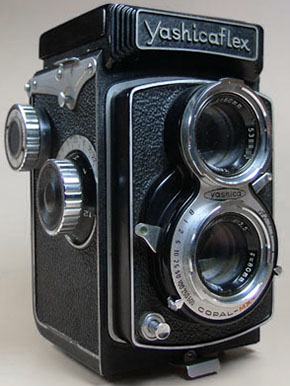 (Detail from larger web image)
(Detail from larger web image)
Serial Numbers
The found body serial numbers are listed in the table further above. Basically, the majority fit into a range beginning with 4 digit serial number 27xx and increase all the way to 5 digit 190xx, then there are three from 270xxx to 288xx, one 381xx, one 1219xx and three from 3300xx to 3303xx.
The lens numbers are a bit all over the place with mostly 2xxxxx and 5xxxxx numbers but also some with 4xxxxx and 6xxxxx numbers and one low number of 199xxx and one high number of 987xxx.
